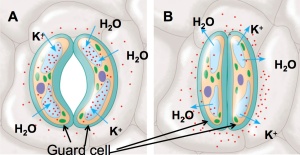A few months ago I wrote a post entitled “How Insects Breathe.” The purpose of that post was to illustrate just how varied the respiratory processes are for animals. And it gets stranger. Gas exchange in an earthworm occurs across their skin as these organisms do not have respiratory organs. Fish, as we all know, have gills, which extract oxygen from the water as it flows opposite in direction to its blood. Regardless if the species is an insect, a human, an earthworm or a fish, the end result is the same. Oxygen enters the body, then diffuses into the cells, where, along with sugar, goes through a series of pathways to produce CO2 , water and energy through a process called cellular respiration. Plants also carry on cellular respiration using the same pathways and processes. Let’s take a look at the chemical reaction for cellular respiration in plants and animals. (The energy produced is not listed here):
![]()
But here’s the clincher. The starting material for respiration is glucose. Plants do not consume sugars, so they must be made by the plant before glycolysis, the Krebs cycle and oxidative phosphorylation occurs. And they do not “breathe” in oxygen, which is also needed for cellular respiration. The plant must produce its own oxygen. The starting material for cellular respiration in plants is produced through the process of photosynthesis. Let’s take a look at the chemical reaction for photosynthesis (Again, minus the energy needed to kick off the reaction):
![]()
Look familiar? It should because it is cellular respiration in reverse, but make no mistakes, other than the fact that the starting and end products of these two processes are reversed, there is nothing similar to them at all. One may speculate that the two processes could become a cycle where their products are recycled over and over again, and that would be the case if it weren’t for the fact that much of the oxygen that is produced in photosynthesis readily leaves the systems. And that is a good thing, otherwise the sugar made by the plant would never be stored and used for our consumption, but would instead be broken down and animals would not be able to survive.
So, how does oxygen leave the system? Or, more precisely, how does oxygen get out of the plant? That task takes place through tiny apertures called the stomata. Stomata are found on the stem, some flower parts, and leaves. In most deciduous plants, stomata are found primarily on the underside of the leaf. The number of stomata varies, and there may be as many as 40,000 per square centimeters on some leaves.
The aperture of the stoma is surround by two specialized cells called guard cells. The alteration in the shape of the guard cells widens to allow CO2 uptake into the plant, and O2 is released int o the atmosphere. Let’s take a look at how this happens. The concept is simple. When water enters the guard cells, the cells swell and become turgid, and because they are attached at their ends, the space between them widens. Why does water enter the guard cells in the first place? Water diffuses from a low to a high concentration of solute. Potassium (K+ ) first enters the guard cell from neighboring cells, and as a result, water follows and the stomata open. This is shown at A on the drawing to the left. When K+ leaves the guard cells, water follows, the guard cells become flaccid and the stomata close. This is illustrated at B.
o the atmosphere. Let’s take a look at how this happens. The concept is simple. When water enters the guard cells, the cells swell and become turgid, and because they are attached at their ends, the space between them widens. Why does water enter the guard cells in the first place? Water diffuses from a low to a high concentration of solute. Potassium (K+ ) first enters the guard cell from neighboring cells, and as a result, water follows and the stomata open. This is shown at A on the drawing to the left. When K+ leaves the guard cells, water follows, the guard cells become flaccid and the stomata close. This is illustrated at B.
Along with the O2, water also exits the plant by way of the stomata. This process is called transpiration, and if left unregulated, the plant will wilt. The job of the plant is to maximize fixation of CO2 into sugars while minimizing water lose. During times of drought or high temperature, the roots produce abscisis acid (ABA), which travels through the plant and signals the guard cells to close. Problem solved. Almost. When droughts persist, the stomata remain closed, CO2 does not enter, the plant does not grow. Thus is the cause of failed crops during times of drought. Sunlight also effects the opening and closing of the guard cells. It would make sense that during daytime when the sun is brightest the stomata will open, because photosynthesis occurs in sunlight. The closing at night will minimize water lose within the plant.
The stomata are one of many fascinating structures found in a plant and can be seen if the underside of a leaf is careful pealed off and place under a microscope. They just might be the most important biological structure on the planet, because without them CO2 will not enter the plant and sugars, the molecule that keeps our cells working, will not be made. The existence of life on Earth may very well indeed be dependent upon the stomata.
